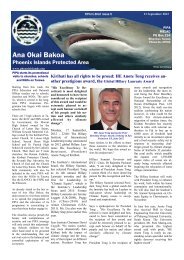Nomination for a World Heritage Site 2009 - Phoenix Islands ...
Nomination for a World Heritage Site 2009 - Phoenix Islands ...
Nomination for a World Heritage Site 2009 - Phoenix Islands ...
Create successful ePaper yourself
Turn your PDF publications into a flip-book with our unique Google optimized e-Paper software.
<strong>Phoenix</strong> <strong>Islands</strong> were the most diverse in terms of species per unit area of shallow water<br />
substrate.<br />
The <strong>Phoenix</strong> <strong>Islands</strong> population of Napoleon<br />
Wrasse (Cheilinus undulates,) usually a good<br />
indicator of local fishing pressure, is exceptional<br />
compared to other internationally recognized<br />
marine biodiversity hotspots recently surveyed in<br />
the Indo-Pacific (Table below). As many as 20-25<br />
individuals were seen on each dive in PIPA. The<br />
population could be quickly devastated if <strong>for</strong>eign<br />
or local ventures started fishing operations. This<br />
species is presently protected under Appendix II<br />
of CITES and although it is not necessarily<br />
threatened by extinction, it could easily vanish if<br />
the trade is not closely controlled.<br />
Photo: David Obura<br />
Frequency of Napoleon Wrasse (Cheilinus undulatus) <strong>for</strong> various locations in the Indo-<br />
Pacific previously surveyed by Conservation International:<br />
Location No. sites % of total Approx. no.<br />
where seen sites seen<br />
<strong>Phoenix</strong> <strong>Islands</strong> 2002 47 83.92 412<br />
Milne Bay, PNG – 2000 28 49.12 90<br />
Milne Bay, PNG – 1997 28 52.83 85<br />
Raja Ampat <strong>Islands</strong> – 2001 7 15.55 7<br />
Togean/Banggai <strong>Islands</strong> – 1998 6 12.76 8<br />
Weh Island, Sumatra – 1999 0 0.00 0<br />
Calamianes Is., Philippines – 1998 3 7.89 5<br />
Shimada (1951) reported that juvenile skipjack were available in the <strong>Phoenix</strong> <strong>Islands</strong>,<br />
indicating that this area was a skipjack spawning area. Further surveys are needed to<br />
determine the extent and importance of the spawning area. Also spawning areas of yellowfin<br />
and bigeye tuna within PIPA need to be investigated.<br />
A list of fish species is attached to the nomination dossier in the Species List attachment.<br />
Marine invertebrates<br />
The motile invertebrate fauna of the <strong>Phoenix</strong> <strong>Islands</strong> is low in diversity, has a number of<br />
taxonomic gaps, and densities of large invertebrates are generally low. During 2002 New<br />
England Aquarium expedition echinoderms were the most diverse and prominent phylum<br />
sampled, though with low species richness, noticeable <strong>for</strong> all the major classes – sea stars, sea<br />
cucumbers, brittle stars and sea urchins. Some species were abundant on all islands, such as<br />
the sea star Linckia multi<strong>for</strong>a and in shallow waters, the urchin Echinometra mathaei.<br />
Kanton and Orona host spectacular giant clam (Tridacna maxima) communities in sizes<br />
rarely seen elsewhere in the world. The density of these giant clams in Orona lagoon is the<br />
highest ever observed by the New England Aquarium expedition scientists (2002), a<br />
particularly unique feature within PIPA. Obura (in press) reported patches of Tridacna<br />
43





